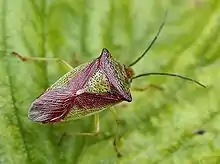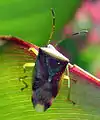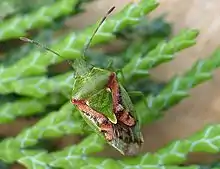Acanthosomatidae
Acanthosomatidae is a family of Hemiptera, commonly named "shield bugs" or "stink bugs", for which Kumar in his 1979 world revision recognized 47 genera; now this number is 55 genera, with about 200 species, and is one of the least diversified families within Pentatomoidea.[1][2] The Acanthosomatidae species are found throughout the world, with the majority in the temperate regions of the Northern Hemisphere.
| Acanthosomatidae | |
|---|---|
 | |
| Acanthosomatidae - relative sizes | |
| Scientific classification | |
| Domain: | Eukaryota |
| Kingdom: | Animalia |
| Phylum: | Arthropoda |
| Class: | Insecta |
| Order: | Hemiptera |
| Suborder: | Heteroptera |
| Superfamily: | Pentatomoidea |
| Family: | Acanthosomatidae Signoret, 1864 |
| Subfamilies | |
|
Acanthosomatinae | |
One of the most well-known species in the Acanthosomatidae family is the hawthorn shield bug (Acanthosoma haemorrhoidale), which is found throughout Europe and also northern Siberia; this species is typically green or brown in color and has a distinctive shape with two projections on its thorax. It feeds on a variety of plants, including hawthorn, rowan, and cherry.
Description
These bugs are characterized by their shield-shaped bodies, which are often adorned with spines or projections, and their ability to emit a foul-smelling liquid when threatened.
Habitat
Acanthosomatidae are found in a variety of habitats, including forests, grasslands, and fields.
Genera
Examples of genera and species:
- Acanthosoma Curtis, 1824
- Acanthosoma haemorrhoidale (Linnaeus, 1758) — Hawthorn shield bug
- Acanthosoma labiduroides Jakovlev, 1880 — Green shield bug
- Cyphostethus Fieber, 1860
- Elasmostethus Fieber, 1860
- Elasmostethus interstinctus — Birch shield bug
- Elasmostethus minor
- Elasmucha Stål, 1864
- Elasmucha cordillera Thomas, 1991
- Elasmucha ferrugata (Fabricius, 1787)
- Elasmucha fieberi (Jakovlev, 1864)
- Elasmucha flammatum (Distant, 1893)
- Elasmucha grisea (Linnaeus, 1758) — Parent bug
- Elasmucha lateralis (Say, 1831)
- Eupolemus
- Oncacontias Breddin, 1903
- Oncacontias vittatus — Forest shield bug
 Rhopalimorpha lineolaris juvenile, last instar
Rhopalimorpha lineolaris juvenile, last instar




 Elasmucha ferrugata
Elasmucha ferrugata
Ecology and use
Like other shield bugs, Acanthosomatidae play an important role in their ecosystems. They help to control insect populations, and their feeding habits can influence the growth and development of plants. However, they can also be considered pests in agricultural fields and gardens, where they may cause damage to crops.
In addition to their ecological significance, Acanthosomatidae have also been studied for their potential medicinal properties. Research has shown that the secretions produced by some species of Acanthosomatidae contain compounds that have anti-inflammatory and anti-tumor properties, making them potentially useful in the development of new drugs.
References
- Faúndez, E. I. 2009. Contribution to the knowledge of the genus Acrophyma Bergroth, 1917 (Hemiptera: Heteroptera: Acanthosomatidae). Zootaxa. 2137: 57-65
- Faúndez, E.I. 2014: A new genus for a Chilean species of Acanthosomatidae (Hemiptera: Heteroptera). Zootaxa, 3768(5): 596-600
